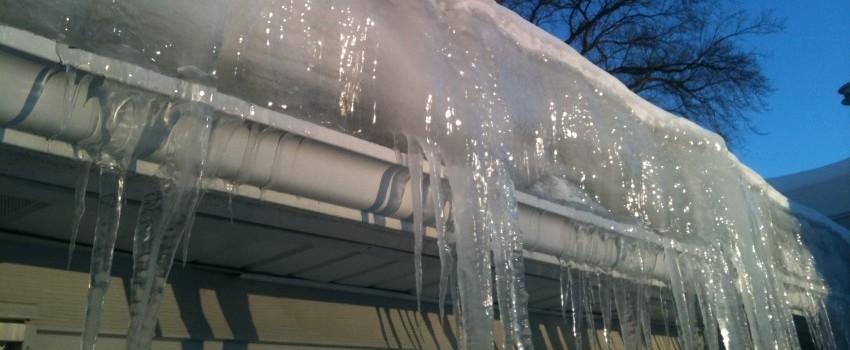This article was originally posted on This Old House and has been lightly edited.

Icicles hanging along the eaves of your house may look beautiful, but they spell trouble. That's because the same conditions that allow icicles to form — snow-covered roofs and freezing weather — also lead to ice dams: thick ridges of solid ice that build up along the eaves. Dams can tear off gutters, loosen shingles, and cause water to back up and pour into your house. When that happens, the results aren't pretty: peeling paint, warped floors, stained and sagging ceilings. Not to mention soggy insulation in the attic, which loses R-value and becomes a magnet for mold and mildew.
Life of an ice dam
Here's a breakdown of the conditions that lead to the formation of ice dams.
First, heat collects in the attic and warms the roof, except at the eaves. Next, snow melts on the warm roof and then freezes on the cold eaves. Finally, ice accumulates along the eaves, forming a dam. Meltwater from the warm roof backs up behind it, flows under the shingles, and into the house.
Fast fixes for ice dams: Blow in cold air, rake It, or deice It
Hacking away at ice dams with a hammer, chisel, or shovel is bad for your roofing — and dangerous for you. And throwing salt on them will do more to harm to your plantings than to the ice. Short of praying for warm weather, here are stop-gap measures we recommend.
Take a box fan into the attic and aim it at the underside of the roof where water is actively leaking in. This targeted dose of cold air will freeze the water in its tracks. "You'll stop the leak in a matter of minutes," says TOH general contractor Tom Silva.
Another option is to pull off snow with a long-handled aluminum roof rake while you stand safely on the ground. A rake with wheels will instantly change the exterior temperature of your roof without damaging shingles.
You can also diminish the damage after the dam has formed with...panty hose! Fill the leg of discarded pair of panty hose with a calcium chloride ice melter. Lay the hose onto the roof so it crosses the ice dam and overhangs the gutter. If necessary, use a long-handled garden rake or hoe to push it into position. The calcium chloride will eventually melt through the snow and ice and create a channel for water to flow down into the gutters or off the roof.
Next up, a list of long-term fixes that will help you get rid of your ice dams for good.
Permanent fixes for ice dams
Getting rid of ice dams for good is simple, in principle: Just keep the entire roof the same temperature as the eaves. You do that by increasing ventilation, adding insulation, and sealing off every possible air leak that might warm the underside of the roof.
By taking care of common trouble spots, listed here in order of priority, you should enjoy dam-free winters and use less energy to boot:
1. Ventilate eaves and ridge. A ridge vent paired with continuous soffit vents circulates cold air under the entire roof. Both ridge and soffit vents should have the same size openings and provide at least 1 square foot of opening for every 300 square feet of attic floor. Place baffles at the eaves to maintain a clear path for the airflow from the soffit vents.
2. Cap the hatch. An unsealed attic hatch or whole-house fan is a massive opening for heat to escape. Cover them with weatherstripped caps made from foil-faced foam board held together with aluminum tape.
3. Exhaust to the outside. Make sure that the ducts connected to the kitchen, bathroom, and dryer vents all lead outdoors through either the roof or walls, but never through the soffit.
4. Add insulation. More insulation on the attic floor keeps the heat where it belongs. To find how much insulation your attic needs, check with your local building department.
5. Install sealed can lights. Old-style recessed lights give off great plumes of heat and can't be insulated without creating a fire hazard. Replace them with sealed "IC" fixtures, which can be covered with insulation.
6. Flash around chimneys. Bridge the gap between chimney and house framing with L-shaped steel flashing held in place with unbroken beads of a fire-stop sealant. Using canned spray foam or insulation isn't fire safe.
7. Seal and insulate ducts. Spread fiber-reinforced mastic on the joints of HVAC ducts and exhaust ducts. Cover them entirely with R-5 or R-6 foil-faced fiberglass.
8. Caulk penetrations. Seal around electrical cables and vent pipes with a fire-stop sealant. Also, look for any spots where light shines up from below or the insulation is stained black by the dirt from passing air.
This Old House is America's most trusted home improvement brand, including the popular PBS television series "This Old House," and Ask This Old House, This Old House Magazine.

Follow us